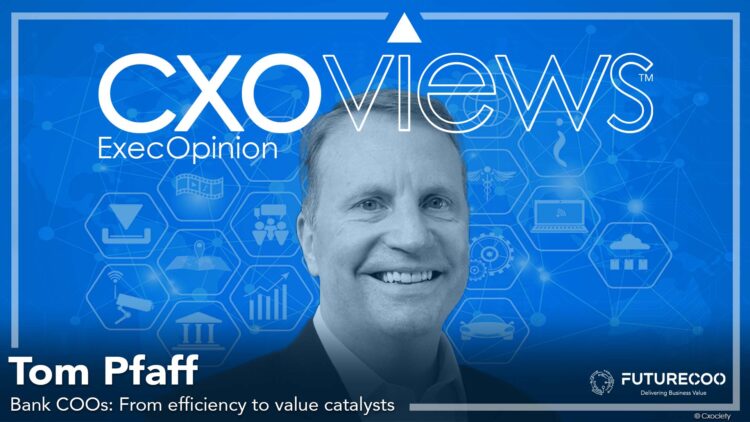In 2025, the role of the chief operating officer within Asia's banking sector is no longer defined by back-office efficiency or process maintenance. The COO—particularly within the Group Chief Financial Office—is emerging as the architect of organisational agility, the bridge between financial strategy and operational execution, and the catalyst for enterprise-wide transformation.
Nowhere is this more critical than in Asia, a region characterised by rapid digital adoption, regulatory complexity, and intensifying competition from both incumbents and fintech disruptors.
Tom Pfaff, chief operating officer within the Group Chief Financial Office at Standard Chartered, captures this shift succinctly: "The role of a COO is growing from being an efficiency enabler to a change catalyst. This means rethinking operating models, embracing technology, AI, and building agility into the way we work."
His words are not aspirational—they are operational imperatives for COOs across Asia's banking landscape in 2025 and 2026.
The mandate of efficiency today, resilience tomorrow
Asia's banking COOs face a dual challenge: maintaining operational excellence in the present while future-proofing their organisations for an uncertain tomorrow.
According to McKinsey & Company, 70% of Asia-Pacific financial institutions plan to increase their technology spending by more than 10% in 2025, with AI, cloud migration, and data modernisation topping the priority list. Yet, technology investment alone is not enough. COOs must ensure these investments translate into measurable operational outcomes and financial returns.
Pfaff's approach offers a blueprint: "It starts with clarity. It is imperative to align operational strategies with financial goals through strong planning and clear prioritisation. We must simplify processes, commoditise where it adds value, and create consistent ways of working across the organisation."
This clarity is especially vital in Asia, where banks operate across dozens of markets, each with distinct regulatory regimes, customer behaviours, and infrastructure maturity. The COO's task is to harmonise operations without homogenising them—to create scalable, standardised platforms that still allow for local adaptability.
At Standard Chartered, this principle is embodied in their 'Aspire' programme, which Pfaff describes as delivering "a controlled, daily source of our detailed transactions across over 50 markets and diverse banking products, that is absolutely essential to enable any digital process and analytics."
For COOs in 2025, such foundational data capabilities are non-negotiable. Without them, AI initiatives falter, risk models degrade, and strategic decisions are made in the dark.
Navigating digital transformation without compromising control
Digital transformation remains the defining theme for Asia's banks. The region is home to some of the world's most digitally engaged banking customers—87% of consumers in markets such as China, India, and Indonesia use mobile banking every week, compared to just 48% in Western Europe. This creates immense opportunity, but also significant risk.
COOs are uniquely positioned to manage this tension. As Pfaff notes, "Strong planning and disciplined execution help minimise risks during transformation. On the financial side, this means ensuring investments in technology and simplification deliver clear returns and do not compromise control."
In 2025, COOs must become stewards of responsible innovation. This means embedding controls into the design of new digital platforms, not bolting them on afterwards.
It means ensuring that AI models are explainable, auditable, and aligned with both financial and regulatory objectives. This involves working closely with the Risk and Compliance functions to prevent regulatory breaches before they occur.
The Monetary Authority of Singapore's 2024 guidelines on AI governance and Hong Kong's recent emphasis on "responsible AI" in financial services underscore the regulatory expectations COOs must navigate. The COO's role is not to slow innovation, but to ensure it is sustainable, scalable, and secure.
Talent, culture, and the human side of transformation
The most underestimated challenge facing COOs in 2025 is talent transformation. Technology can be procured, processes can be redesigned—but people must be inspired, upskilled, and aligned.
Pfaff places this at the heart of his operating philosophy: "Talent development drives performance when it is practical and embedded in daily work. We do not believe in working in silos, particularly when it comes to talent development. We partner closely with HR to invest in learning and development of all colleagues in the Bank."
His team's initiatives—ranging from leadership reflection circles to innovation labs that "foster psychological safety and learning how to turn failures into opportunities"—are not HR programmes.
They are operational imperatives. In an era where 44% of banking roles in Asia are expected to require significant reskilling by 2026, COOs cannot afford to treat talent as a "support function."
Instead, COOs must own the integration of capability building into the workflow. This means creating pathways for colleagues to "pursue short-term assignments across the function to expand capabilities," as Pfaff describes, or ensuring "a plethora of courses that colleagues can access anytime to upskill."
The goal is not just to fill skill gaps, but to cultivate a culture of continuous learning and adaptive execution.
Culture, in this context, is not something to be taken lightly. It is an operational infrastructure. A team that fears failure will be less likely to experiment with AI. A team that lacks cross-functional trust will not collaborate on enterprise-wide simplification. The COO, therefore, must be as fluent in cultural levers as they are in process maps.
A partnership that is complementary, not competitive
One of the most delicate dynamics in the modern Bank is the relationship between the COO and CFO. As the COO's remit expands into areas like data strategy, digital enablement, and enterprise architecture, the risk of role overlap—or worse, role confusion—increases.
Pfaff offers a clear framework: "The goal of a COO for a finance function has never been about replicating the CFO's role. Although finance COOs need to strengthen their financial expertise, it's more about developing enough depth to understand the financial impact of operational choices and to speak the same language at the leadership table.

"We have clear boundaries —the CFO leads on financial strategy and stewardship, while the COO ensures operational execution to support these goals. When both roles complement each other, it creates alignment without overlap." Tom Pfaff
In 2025, this partnership will be tested like never before. As CFOs are pressured to deliver more granular, real-time financial insights—and as regulators demand greater transparency into cost structures and capital allocation—the COO's ability to provide clean, timely, and integrated operational data becomes mission-critical.
The COO must not only "speak the same language" as the CFO but also anticipate their needs. This means building finance functions that are "a trusted partner that delivers world-class control and insight, enabling the business to achieve its commercial objectives," as Pfaff puts it.
It also means going further: "opening up these capabilities to the wider business, enabling teams to draw on finance's data, controls, and the digital platforms, and turning them into enterprise-wide assets—powering sharper decisions, bolder moves, and stronger results across the business."
In essence, the COO's success in 2025 will be measured not just by cost savings or process speed, but by how effectively they enable the entire organisation to make better, faster, more informed decisions.
Investing in the COO: Leading from the front
Finally, COOs must lead by example. The pace of change in Asia's banking sector demands leaders who are intellectually curious, technically literate, and relentlessly adaptive.
Pfaff embodies this: "Two years ago, I started to pursue a PhD focusing on AI, which I find fascinating, and also helps to keep me fresh and constantly fuelling new ideas to incorporate into my COO responsibilities."
This is not an indulgence—it is strategic leadership. In 2025, COOs who delegate learning to their teams while remaining operationally focused will fall behind.
The most effective COOs will be those who immerse themselves in emerging technologies, study behavioural science to understand organisational change, and engage with ecosystems beyond banking—from fintech startups to academic institutions.
Collaboration: The glue that holds it all together
None of this is possible in isolation. As Pfaff observes, "Cross-functional collaboration works best when we build trust and clarity at the same time. When we focus on setting shared priorities early, being transparent on who owns what, and making sure colleagues see how their work connects to the bigger outcomes."
In Asia's matrixed, multi-market banking organisations, the COO must be the integrator-in-chief. At Standard Chartered, Pfaff works "very closely with my COO peers in the Business, Risk, and HR functions to ensure we are joined up and ensuring consistency across the Bank in our mutual roles."
This model of "joined-up COO-ship" will define success in 2025–2026. The COO who operates in a silo will deliver sub-scale results. The COO who convenes, aligns, and orchestrates cross-functional teams will drive enterprise-wide value.
The COO as value creator
The era of the COO as a "back-office operator" is over. In Asia's dynamic, digital-first banking environment, the COO is a value creator, a culture shaper, a technology enabler, and a strategic partner to the CFO.
As Pfaff reminds us, transformation is not a project—it is a mindset: "For me, transformation is about simplifying operations, embedding technology, and building a finance function that is future ready."
In 2025 and 2026, Asia's banking COOs will be judged not by how well they maintained the status quo, but by how boldly they reimagined it. The tools are available: AI, cloud, data, and agile ways of working.
The mandate is clear: efficiency, resilience, and growth. The question is not whether COOs can rise to the challenge, but how quickly they will choose to take the lead.
The future of Asia's banks requires not only strong CFOs but also effective leadership. It needs visionary COOs.



